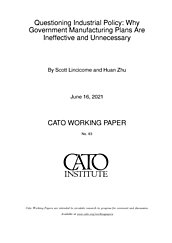An updated and improved version of this paper was released by Cato on September 28, 2021.
Questioning Industrial Policy: Why Government Manufacturing Plans Are Ineffective and Unnecessary
American policymakers on the left and right have once again embraced “industrial policy” to address fix alleged U.S. market failures and to counter China’s own economic interventions.
In the wake of the COVID-19 pandemic and rising U.S.-China tensions, American policymakers have again embraced “industrial policy.” Both President Biden and his predecessor, as well as legislators from both parties, have advocated a range of federal support for American manufacturers to fix perceived weaknesses in the U.S. economy and to counter China’s growing economic clout.
These and other industrial policy advocates, however, routinely leave unanswered important questions about U.S. industrial policy’s efficacy and necessity:
What is “Industrial Policy”? Advocates of “industrial policy” often fail to define the term, thus permitting them to ignore past failures and embrace false successes while preventing a legitimate assessment of industrial policies’ costs and benefits. Yet U.S. industrial policy’s history of debate and implementation establishes several requisite elements – elements that reveal most “industrial policy successes” not to be “industrial policy” at all.
What are the common obstacles to effective U.S. industrial policy? Several obstacles have prevented U.S. industrial policies from generating better outcomes than the market. This includes legislators’ and bureaucrats’ inability to “pick winners” and efficiently allocate public resources (Hayek’s “Knowledge Problem”); factors inherent in the U.S. political system (Public Choice Theory); lack of discipline regarding scope, duration, and budgetary costs; interaction with other government policies that distort the market at issue; and substantial unseen costs.
What “problem” will industrial policy solve? The most common problems purportedly solved by industrial policy proposals are less serious than advocates claim or unfixable via industrial policy. This includes allegations of widespread U.S. “deindustrialization” and a broader decline in American innovation; the disappearance of “good jobs”; the erosion of middle-class living standards; and the destruction of American communities.
Do other countries’ industrial policies demand U.S. industrial policy? The experiences of other countries generally cannot justify U.S. industrial policy because countries have different economic and political systems. Regardless, industrial policy successes abroad – for example, in Japan, Korea and Taiwan – are exaggerated. Also, China’s economic growth and industrial policies do not justify similar U.S. policies, considering the market-based reasons for China’s rise, the Chinese policies’ immense costs, and the systemic challenges that could derail China’s future growth and geopolitical influence.
These answers argue strongly against a new U.S. embrace of industrial policy. The United States undoubtedly faces economic and geopolitical challenges, including ones related to China, but the solution lies not in copying China’s top-down economic planning. Reality, in fact, argues much the opposite.

This work is licensed under a Creative Commons Attribution-NonCommercial-ShareAlike 4.0 International License.

